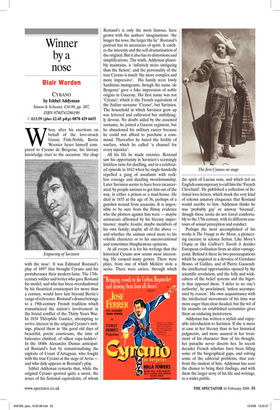Winner by a nose
Blair Worden
CYRANO by Ishbel Addyman Simon & Schuster, £16.99, pp. 307, ISBN 9780743286190 ✆ £13.59 (plus £2.45 p&p) 0870 429 6655 When, after his exertions on behalf of the love-struck Gussie Fink-Nottle, Bertie Wooster hears himself compared to Cyrano de Bergerac, his literary knowledge rises to the occasion: ‘the chap with the nose’. It was Edmund Rostand’s play of 1897 that brought Cyrano and his protuberance their modern fame. The 17thcentury soldier and writer who gave Rostand his model, and who has been overshadowed by his theatrical counterpart for more than a century, would have lain beyond Bertie’s range of reference. Rostand’s drama belongs to a 19th-century French tradition which romanticised the nation’s involvement in the brutal conflict of the Thirty Years War. In 1834 Théophile Gautier, attempting to revive interest in the original Cyrano’s writings, placed them in ‘the good old days of beautiful, poetic courtesans, the time of balconies climbed, of silken rope-ladders’. In the 1840s Alexandre Dumas anticipated Rostand’s feat by sensationalising the exploits of Count d’Artagnan, who fought with the true Cyrano at the siege of Arras — and who duly appears in Rostand’s play.
Ishbel Addyman remarks that, while the original Cyrano sported quite a snout, the noses of his fictional equivalents, of whom Rostand’s is only the most famous, have grown with the authors’ imaginations: ‘the longer the nose, the larger the lie’. Rostand’s portrait has its accuracies of spirit. It catches the intensity and the self-dramatisation of the original. But it also has its distortions and simplifications. The truth, Addyman plausibly maintains, is ‘infinitely more intriguing than the fiction’, and the personality of the true Cyrano is much ‘the more complex and more impressive’. His family were lowly Sardinian immigrants, though the name ‘de Bergerac’ gave a fake impression of noble origins in Gascony. His first name was not ‘Cyrano’, which is the French equivalent of the Italian surname ‘Cirano’, but Savinien. The household in which Savinien grew up was lettered and cultivated but stultifyingly devout. No doubt aided by the assumed surname, he joined a Gascon regiment, but he abandoned his military career because he could not afford to purchase a command. Thereafter he hated the futility of warfare, which he called ‘a channel for every injustice’.
All his life he made enemies. Rostand saw his opportunity in Savinien’s seemingly limitless taste for duelling, and in a celebrated episode in 1842 when he single-handedly repelled a gang of assailants with reckless courage and dazzling swordsmanship. Later Savinien seems to have been incarcerated, by people anxious to get him out of the way, in either a prison or a mad-house. He died in 1655 at the age of 36, perhaps of a gunshot wound from assassins. It is impossible to be sure from the flimsy evidence who the plotters against him were — maybe aristocrats affronted by his literary impertinence; maybe Jesuits; maybe members of his own family; maybe all of the above — and whether the animus owed more to his volatile character or to his unconventional and sometimes blasphemous opinions.
At all events it is for his writings that the historical Cyrano now seems most interesting. He essayed many genres. There were plays, from one of which Molière stole a scene. There were satires, through which the spirit of Lucian runs, and which led an English contemporary to call him the ‘French Cleveland’. He published a collection of fictional love-letters, which mock the very kind of solemn amatory eloquence that Rostand would ascribe to him. Addyman thinks he was ‘probably gay’ or anyway ‘bisexual’, though those terms do not travel comfortably to the 17th century, with its different contours of sexual perception and conduct.
Perhaps the most accomplished of his works is The Voyage to the Moon, a pioneering exercise in science fiction. Like More’s Utopia or like Gulliver’s Travels it derides European civilisation from an alien vantagepoint. Behind it there lie two preoccupations which he acquired as a devotee of Giordano Bruno, of Galileo, and of Pierre Gassendi: the intellectual opportunities opened by the scientific revolution, and the folly and wickedness of the belief systems and the bigotry that opposed them. ‘I defer to no one’s authority’, he proclaimed, ‘unless accompanied by reason’. His own acquaintance with the intellectual movements of his time was more eager than clear-headed, but the wit of his assaults on established certainties gives them an enduring incisiveness.
Addyman has written a stylish and enjoyable introduction to Savinien. If she is more at ease in her literary than in her historical judgments, and more assured in her treatment of his character than of his thought, her panache never deserts her. In recent decades French scholars have been filling some of the biographical gaps, and solving some of the editorial problems, that confront the student of him. Addyman has seen the chance to bring their findings, and with them the larger story of his life and writings, to a wider public.


















































































 Previous page
Previous page